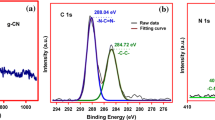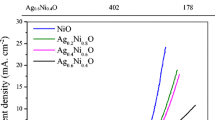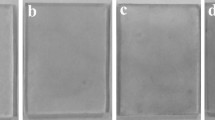Abstract
We demonstrate a facile galvanic replacement reaction route to direct growth of silver nanoparticles (AgNPs) into porous alumina on conductive glass (PAOCG). Porous Al2O3 layer was prepared by using boehmite as precursor, deposited on conductive glass via spin coating, and followed by a heat treatment. PAOCG was attached firmly with a tiny sheet of steel and was then soaked in AgNO3 solution. Ag+ ions in the nanopores of PAOCG adsorbed by capillarity were automatically reduced to metallic AgNPs, thus forming Ag/PAOCG. The catalytic property of Ag/PAOCG was investigated for p-nitrophenol (PNP) reduction using UV–Vis absorption spectroscopy, and the rate constant was evaluated using the pseudo-first-order kinetic model. This film catalyst could be readily regenerated and reused for up to ten times without significantly depreciate its efficiency. The SERS performance of Ag/PAOCG was investigated using aqueous crystal violet (CV) as a probe molecule. The optimum Ag/PAOCG substrate was capable of detecting as low as 10−10 M aqueous CV. The reusability of Ag/PAOCG was achieved by heating the substrate at 400 °C for 5 min in air. This substrate could be reused for at least five cycles without significantly reduced SERS performance. Therefore, this powerful multifunctional surface can serve as a portable, durable and reusable substrate for PNP reduction and SERS applications.













Similar content being viewed by others
References
Sahiner N, Yildiz S, Al-Lohedan H (2015) The resourcefulness of p(4-VP) cryogels as template for in situ nanoparticle preparation of various metals and their use in H2 production, nitro compound reduction and dye degradation. Appl Catal B 166:145–154
Shimizu K, Miyamoto Y, Satsuma A (2010) Size-and support-dependent silver cluster catalysis for chemoselective hydrogenation of nitroaromatics. J Catal 270:86–94
Gemini VL, Gallego A, de Oliveira VM, Gomez CE, Manfio GP, Korol SE (2005) Biodegradation and detoxification of p-nitrophenol by rhodococcus wratislaviensis. Int Biodeterior Biodegrad 55:103–108
Torres-Martínez CL, Kho R, Mian OI, Mehra RK (2001) Efficient photocatalytic degradation of environmental pollutants with mass-produced ZnS nanocrystals. J Colloid Interface Sci 240:525–532
Borras C, Laredo T, Scharifker BR (2003) Competitive electrochemical oxidation of p-chlorophenol and p-nitrophenol on Bi-doped PbO2. Electrochim Acta 48:2775–2780
Dauthal P, Mukhopadhyay M (2012) Prunus domestica fruit extract-mediated synthesis of gold nanoparticles and its catalytic activity for 4-nitrophenol reduction. Ind Eng Chem Res 51:13014–13020
Li XZ, Wu KL, Ye Y, Wei XW (2013) Gas-assisted growth of boron-doped nickel nanotube arrays: rapid synthesis, growth mechanisms, tunable magnetic properties, and super-efficient reduction of 4-nitrophenol. Nanoscale 5:3648–3653
Zhang W, Tan F, Wang W, Qiu X, Qiao X, Chen J (2012) Facile, template-free synthesis of silver nanodendrites with high catalytic activity for the reduction of p-nitrophenol. J Hazard Mater 217:36–42
Devi LB, Mandal AB (2013) Self-assembly of Ag nanoparticles using hydroxypropyl cyclodextrin: synthesis, characterisation and application for the catalytic reduction of p-nitrophenol. RSC Adv 3:5238–5253
Péron O, Rinnert E, Lehaitre M (2009) Detection of polycyclic aromatic hydrocarbon (PAH) compounds in artificial sea-water using surface-enhanced Raman scattering (SERS). Talanta 79:199–204
Yu J, Yang J, Sun D, Wang T (2016) A novel nanoporous surface for immobilization and expression of functional chemicals. Mater Lett 180:148–152
Zong S, Wang Z, Yang J, Wang C, Xu S, Cui Y (2012) A SERS and fluorescence dual mode cancer cell targeting probe based on silica coated Au@Ag core–shell nanorods. Talanta 97:368–375
Yu J, Shen M, Liu S, Li F, Sun D, Wang T (2017) A simple technique for direct growth of Au into a nanoporous alumina layer on conductive glass as a reusable SERS substrate. Appl Surf Sci 406:285–293
Li X, Chen G, Yang L, Jin Z, Liu J (2010) Multifunctional Au-coated TiO2 nanotube arrays as recyclable SERS substrates for multifold organic pollutants detection. Adv Funct Mater 20:2815–2824
Wang G, Lipert RJ, Jain M, Kaur S, Chakraboty S, Torres MP, Batra SK, Brand RE, Porter MD (2011) Detection of the potential pancreatic cancer marker MUC4 in serum using surface-enhanced Raman scattering. Anal Chem 83:2554–2561
Wei G, Zhou H, Liu Z, Li Z (2005) A simple method for the preparation of ultrahigh sensitivity surface enhanced Raman scattering (SERS) active substrate. Appl Surf Sci 240:260–267
Zhang Z, Yu J, Yang J, Lv X, Wang T (2005) Preparation of sensitive and recyclable porous Ag/TiO2 composite films for SERS detection. Appl Surf Sci 359:853–859
Kumar A, Vemula PK, Ajayan PM, John G (2008) Silver-nanoparticle-embedded antimicrobial paints based on vegetable oil. Nat Mater 7:236–241
Wang HH, Liu CY, Wu SB, Liu NW, Peng CY, Chan TH, Hsu CF, Wang JK, Wang YL (2006) Highly Raman-enhancing substrates based on silver nanoparticle arrays with tunable sub-10 nm gaps. Adv Mater 18:491–495
Liu B, Wang T, Yin C, Wei Z (2014) Electrochemical analysis of p-nitrophenol in acidic or alkaline medium using silver nanoparticle decorated multi-walled carbon nanotubes. J Mater Sci 49:5398–5405. doi:10.1007/s10853-014-8251-y
Zhao W, Wang H, Qin X, Wang X, Zhao Z, Miao Z, Chen L, Shan M, Fang Y, Chen Q (2009) A novel nonenzymatic hydrogen peroxide sensor based on multi-wall carbon nanotube/silver nanoparticle nanohybrids modified gold electrode. Talanta 80:1029–1033
Feng Z, Yu J, Kong J, Wang T (2016) A novel porous Al2O3 layer/AgNPs-Hemin composite for degradation of azo dyes under visible and UV irradiation. Chem Eng J 294:236–245
Ensafi AA, Rezaloo F, Rezaei B (2016) Electrochemical sensor based on porous silicon/silver nanocomposite for the determination of hydrogen peroxide. Sens Actuators B Chem 231:239–244
Muzikansky A, Nanikashvili P, Grinblat J, Zitoun D (2013) Ag dewetting in Cu@Ag monodisperse core–shell nanoparticles. J Phys Chem C 117:3093–3100
Stewart IE, Ye S, Chen Z, Flowers PF, Wiley BJ (2015) Synthesis of Cu–Ag, Cu–Au, and Cu–Pt core–shell nanowires and their use in transparent conducting films. Chem Mater 27:7788–7794
Oh MH, Yu T, Yu SH, Lim B, Ko KT, Willinger MG, Seo DH, Kim BH, Cho MG, Park JH, Kang K, Sung YE, Pinna N, Hyeon T (2013) Galvanic replacement reactions in metal oxide nanocrystals. Science 340:964–968
Xia X, Wang Y, Ruditskiy A, Xia Y (2013) 25th anniversary article: galvanic replacement: a simple and versatile route to hollow nanostructures with tunable and well-controlled properties. Adv Mater 25:6313–6333
Pearson A, O’Mullane AP, Bansal V, Bhargava SK (2010) Galvanic replacement mediated transformation of Ag nanospheres into dendritic Au–Ag nanostructures in the ionic liquid [BMIM][BF 4]. Chem Commun 46:731–733
Yang B, Guo Z, Zhang W, Wan M, Qin X, Zhong H (2014) In situ green synthesis of silver–graphene oxide nanocomposites by using tryptophan as a reducingand stabilizing agent and their application in SERS. Appl Surf Sci 316:22–27
Ye W, Chen Y, Zhou F, Wang C, Li Y (2012) Fluoride-assisted galvanic replacement synthesis of Ag and Au dendrites on aluminum foil with enhanced SERS and catalytic activities. J Mater Chem 22:18327–18334
Aizawa M, Cooper AM, Malac M, Buriak JM (2005) Silver nano-inukshuks on germanium. Nano Lett 5:815–819
Xin B, Jing L, Ren Z, Wang B, Fu H (2005) Effects of simultaneously doped and deposited Ag on the photocatalytic activity and surface states of TiO2. J Phys Chem B 109:2805–2809
Gao F, Yang Y, Wang T (2015) Preparation of porous TiO2/Ag heterostructure films with enhanced photocatalytic activity. Chem Eng J 270:418–427
Prieto J, Nistor V, Nouneh K, Oyama M, Abd-Lefdil M, Díaz R (2012) XPS study of silver, nickel and bimetallic silver-nickel nanoparticles prepared by seed-mediated growth. Appl Surf Sci 258:8807–8813
Xia J, He G, Zhang L, Sun X, Wang X (2016) Hydrogenation of nitrophenols catalyzed by carbon back-supported nickel nanoparticles under mild conditions. Appl Catal B 180:408–415
Pradhan N, Pal A, Pal T (2001) Catalytic reduction of aromatic nitro compounds by coinage metal nanoparticles. Langmuir 17:1800–1802
Han J, Fang P, Jiang W, Li L, Guo R (2012) Ag-nanoparticle-loaded mesoporous silica: spontaneous formation of Ag nanoparticles and mesoporous silica SBA-15 by a one-pot strategy and their catalytic applications. Langmuir 28:4768–4775
Wu T, Chen M, Zhang L, Xu X, Liu Y, Yan J, Wang W, Gao J (2013) Three-dimensional graphene-based aerogels prepared by a self-assembly process and its excellent catalytic and absorbing performance. J Mater Chem A 1:7612–7621
Dandapat A, Jana D, De G (2009) Synthesis of thick mesoporous γ-Alumina films, loading of Pt nanoparticles, and use of the composite film as a reusable catalyst. ACS Appl Mater Inter 1:833–840
Du X, He J, Zhu J, Sun L, An S (2012) Ag-deposited silica-coated Fe3O4 magnetic nanoparticles catalyzed reduction of p-nitrophenol. Appl Surf Sci 258:2717–2723
Zhang W, Tan F, Wang W, Qiu X, Qiao X, Chen J (2012) Facile, template-free synthesis of silver nanodendrites with high catalytic activity for the reduction of p-nitrophenol. J Hazard Mater 217:36–42
Sanci R, Volkan M (2009) Surface-enhanced Raman scattering (SERS) studies on silver nanorod substrates. Sens Actuators B Chem 139:150–155
An Q, Zhang P, Li JM, Ma WF, Guo J, Hu J, Wang CC (2012) Silver-coated magnetite-carbon core-shell microspheres as substrate-enhanced SERS probes for detection of trace persistent organic pollutants. Nanoscale 4:5210–5216
Chen HY, Lin MH, Wang CY, Chang YM, Gwo S (2015) Large-scale hot spot engineering for quantitative SERS at the single-molecule scale. J Am Chem Soc 137(42):13698–13705
Panigrahi S, Praharaj S, Basu S, Ghosh SK, Jana S, Pande S, Vo-Dinh T, Jiang H, Pal T (2006) Self-assembly of silver nanoparticles: synthesis, stabilization, optical properties, and application in surface-enhanced Raman scattering. J Phys Chem B 110:13436–13444
Kleinman SL, Ringe E, Valley N, Phillips KLE, Scheidt KA, Schatz GC, Van Duyne RP (2011) Single-molecule surface-enhanced Raman spectroscopy of crystal violet isotopologues: theory and experiment. J Am Chem Soc 133:4115–4122
Yu J, Liu S, Li F, Wang T (2016) Na2SiO3/Al2O3 composite coatings on 304 stainless steels for enhanced high temperature oxidation inhibition and chloride-induced corrosion resistance. Surf Coat Tech 309:1089–1098
Feng Z, Yu J, Sun D, Wang T (2016) Visible-light-driven photocatalysts Ag/AgCl dispersed on mesoporous Al2O3 with enhanced photocatalytic performance. J Colloid Interface Sci 480:184–190
Acknowledgement
We are grateful to the Scientific Research Foundation of Nanjing University of Science and Technology (AE89909) for financial support. A project was funded by the Priority Academic Program Development (PAPD) of Jiangsu Higher Education Institutions.
Author information
Authors and Affiliations
Corresponding author
Ethics declarations
Conflict of interest
The authors declare that they have no conflict of interest.
Rights and permissions
About this article
Cite this article
Liu, S., Yu, J., Wang, T. et al. A multifunctional Ag/PAOCG reusable substrate for p-nitrophenol reduction and SERS applications. J Mater Sci 52, 13748–13763 (2017). https://doi.org/10.1007/s10853-017-1461-3
Received:
Accepted:
Published:
Issue Date:
DOI: https://doi.org/10.1007/s10853-017-1461-3




